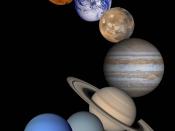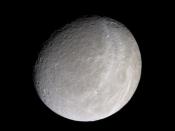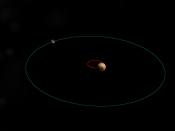Jupiter, Saturn, Uranus, and Neptune. They are also called the Jovian Planets. These planets are grouped together because they are alike in many ways. The four are made up of frozen gases. The Jovian Planets also have in common density. They are all very light, about the density of water. Saturn is even lighter then water. If you could fit Saturn in a bath tub filled with water, the planet would float in it.
Besides the sun, Jupiter is the largest object in the solar system. It is so big that more then 1,000 Earths could fit in it. Not counting the sun, Jupiter contains more then 70 percent of all the material in our solar system. Its enormous size means that Jupiter has a very strong gravitational pull, about 318 times greater then the gravitational pull of Earth.
Saturn is the second largest planet of all.
It is also the most distant planet that was known to ancient people. Although it is small compared to Jupiter, it is ninety five times more massive then Earth. Saturn's average density is less then that of water. Because it is both smaller then Jupiter and twice as far from Earth. It is not always easy to observe this planet clearly though telescopes.
Uranus has an unusual rotation. It appears to be lying on its side. Therefore it turns almost like a snow ball rolling downhill. Because of this, as it travels through its eighty-four-year path around the sun, there are decades when its north or south poles are in total darkness.
Uranus's path around the sun could not be calculated as perfectly as it should have been. So the gravitational pull of some thing beyond Uranus was thought to be causing it to move just slightly out of...


